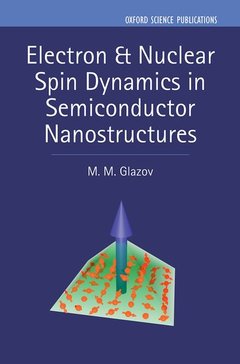Description
Electron & Nuclear Spin Dynamics in Semiconductor Nanostructures
Series on Semiconductor Science and Technology Series, Vol. 23
Author: Glazov M. M.
Language: English
Approximative price 120.27 €
In Print (Delivery period: 21 days).
Add to cart
Publication date: 09-2018
294 p. · 16.3x23.5 cm · Hardback
294 p. · 16.3x23.5 cm · Hardback
Description
/li>Biography
/li>
In recent years, the physics community has experienced a revival of interest in spin effects in solid state systems. On one hand, the solid state systems, particularly, semiconductors and semiconductor nanosystems, allow us to perform benchtop studies of quantum and relativistic phenomena. On the other hand, this interest is supported by the prospects of realizing spin-based electronics, where the electron or nuclear spins may play a role of quantum or classical information carriers. This book looks in detail at the physics of interacting systems of electron and nuclear spins in semiconductors, with particular emphasis on low-dimensional structures. These two spin systems naturally appear in practically all widespread semiconductor compounds. The hyperfine interaction of the charge carriers and nuclear spins is particularly prominent in nanosystems due to the localization of the charge carriers, and gives rise to spin exchange between these two systems and a whole range of beautiful and complex physics of manybody and nonlinear systems. As a result, understanding of the intertwined spin systems of electrons and nuclei is crucial for in-depth studying and controlling the spin phenomena in semiconductors. The book addresses a number of the most prominent effects taking place in semiconductor nanosystems including hyperfine interaction, nuclear magnetic resonance, dynamical nuclear polarization, spin-Faraday and spin-Kerr effects, processes of electron spin decoherence and relaxation, effects of electron spin precession mode-locking and frequency focussing, as well as fluctuations of electron and nuclear spins.
M. M. Glazov graduated from the Polytechnical University (St.-Petersburg, Russia) in 2005, after defence of his master of physics thesis on effects of electron-electron interactions on spin relaxation in semiconductors. He obtained a PhD in semiconductor physics at Ioffe Institute 2008 after defending the thesis "Spin dynamics of electrons and excitons in quantum wells and quantum dots", and defended the Habilitation (Doctor of Sciences in Russia) "Spin and kinetic phenomena in nanostructures and graphene" in 2012 also at Ioffe Institute. In 2016, Mikhail was elected as a corresponding member to Russian Academy of Sciences. His research interests include theory of spin effects in semiconductors, physics of two-dimensional materials and light-matter coupling effects.
© 2024 LAVOISIER S.A.S.




